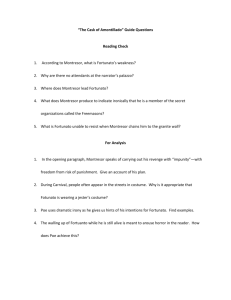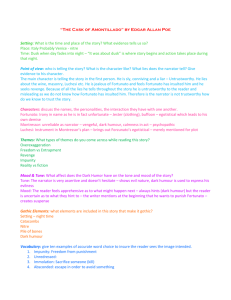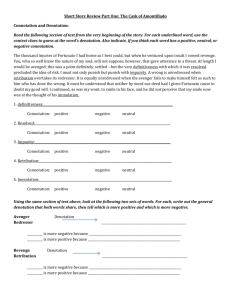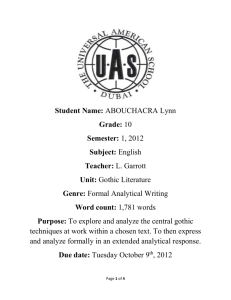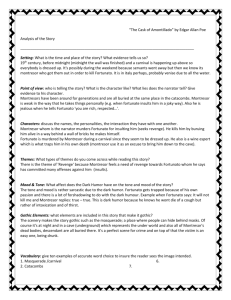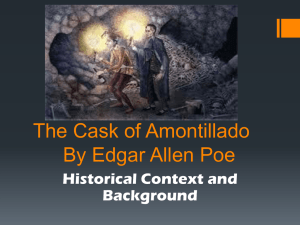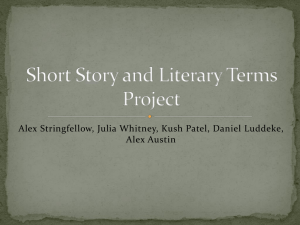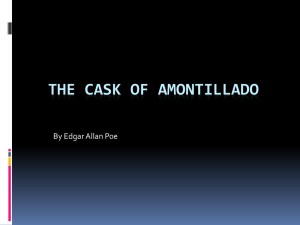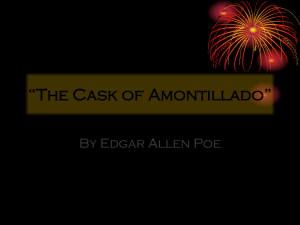The Cask of Amontillado literary analysis questions
advertisement
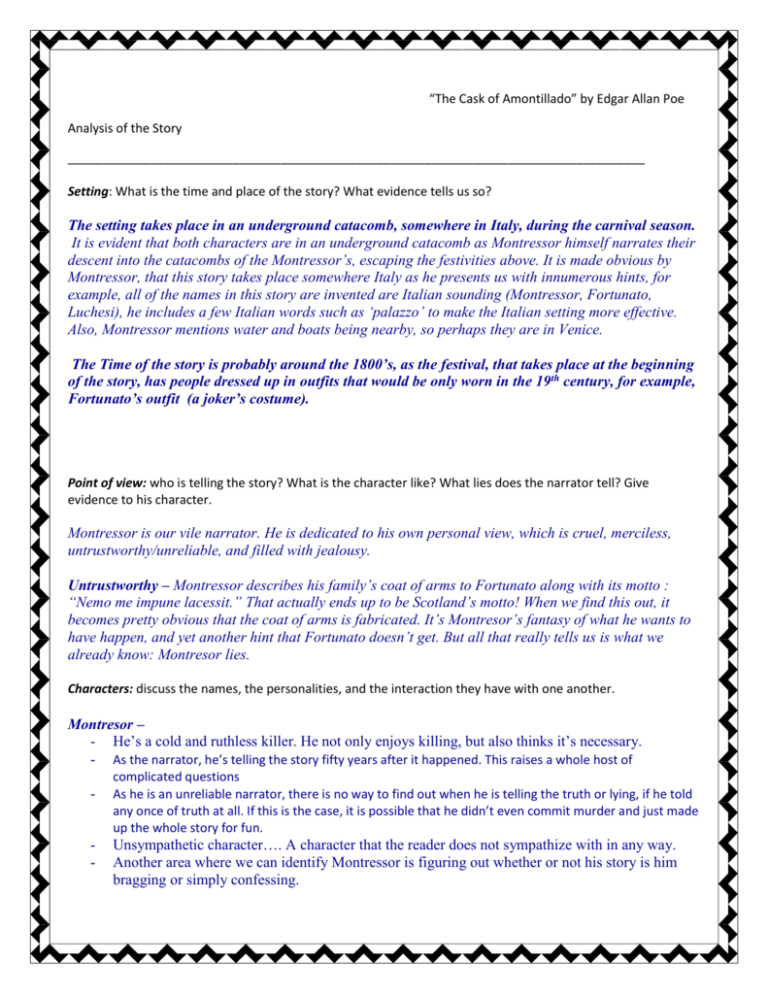
“The Cask of Amontillado” by Edgar Allan Poe Analysis of the Story ____________________________________________________________________________________ Setting: What is the time and place of the story? What evidence tells us so? The setting takes place in an underground catacomb, somewhere in Italy, during the carnival season. It is evident that both characters are in an underground catacomb as Montressor himself narrates their descent into the catacombs of the Montressor’s, escaping the festivities above. It is made obvious by Montressor, that this story takes place somewhere Italy as he presents us with innumerous hints, for example, all of the names in this story are invented are Italian sounding (Montressor, Fortunato, Luchesi), he includes a few Italian words such as ‘palazzo’ to make the Italian setting more effective. Also, Montressor mentions water and boats being nearby, so perhaps they are in Venice. The Time of the story is probably around the 1800’s, as the festival, that takes place at the beginning of the story, has people dressed up in outfits that would be only worn in the 19th century, for example, Fortunato’s outfit (a joker’s costume). Point of view: who is telling the story? What is the character like? What lies does the narrator tell? Give evidence to his character. Montressor is our vile narrator. He is dedicated to his own personal view, which is cruel, merciless, untrustworthy/unreliable, and filled with jealousy. Untrustworthy – Montressor describes his family’s coat of arms to Fortunato along with its motto : “Nemo me impune lacessit.” That actually ends up to be Scotland’s motto! When we find this out, it becomes pretty obvious that the coat of arms is fabricated. It’s Montresor’s fantasy of what he wants to have happen, and yet another hint that Fortunato doesn’t get. But all that really tells us is what we already know: Montresor lies. Characters: discuss the names, the personalities, and the interaction they have with one another. Montresor – - He’s a cold and ruthless killer. He not only enjoys killing, but also thinks it’s necessary. - As the narrator, he’s telling the story fifty years after it happened. This raises a whole host of - complicated questions As he is an unreliable narrator, there is no way to find out when he is telling the truth or lying, if he told any once of truth at all. If this is the case, it is possible that he didn’t even commit murder and just made up the whole story for fun. Unsympathetic character…. A character that the reader does not sympathize with in any way. Another area where we can identify Montressor is figuring out whether or not his story is him bragging or simply confessing. - Jealous. Throughout the story Montressor sarcastically praises and lists Fortunato’s great achievements/wealth/popularity… gives us readers the impression that he is really jealous. Montressor is probably jealous because, like Fortunato, he once was wealthy….but something must’ve happened. Did Fortunato have something to do with it? Fortunato – - Addicted to wine - Insenitive. Whether he insulted and hurt Montressor, Fortunato doesn’t seem to notice - Proud and Greedy. Maybe Montresor doesn’t need to bring up Luchesi to get Fortunato down in the hole, but it doesn’t hurt. Fortunato either wants to prove that he’s a better wine taster than Luchesi, or he wants to make sure Luchesi doesn’t get his hands on the Amontillado. - Gullible. He was too trusting and this served to be a weakness as trusting Montressor was definitely a mistake. Themes: What types of themes do you come across while reading this story? - Freedom and Confinement Betrayal Drugs and alcohol Mortality Foolishness and folly. Mood & Tone: What affect does the Dark Humor have on the tone and mood of the story? Montresor describes the mounds of bones and stench of human remains so elegantly, it almost sounds beautiful. The following passage is a good example: “We passed through a range of low arches, descended, passed on, and descending again, arrived at a deep crypt, in which the foulness of the air caused our flambeaux rather to glow than flame.” The creepily humorous tone also adds to our engagement in the story. In addition to being entertaining, Montresor’s sinister (and usually somewhat lame) jokes (like the one about how he gets his servants out of the house in paragraph 24) make us believe, for a moment, that everything is going be OK. If we can still laugh, it must not be so bad. When Gothic Elements: what elements are included in this story that make it gothic? Catacombs, mounds of bones and stench of human (“We passed through a range of low arches, descended, passed on, and descending again, arrived at a deep crypt, in which the foulness of the air caused our flambeaux [torches – pronounced “flam-bow”] rather to glow than flame.”), Vocabulary: give ten examples of accurate word choice to insure the reader sees the image intended. 1. Roquelaure - knee length often fur trimmed cloak 2. Trowel - any of various tools having a flat blade with a handle, used for depositing and working mortar, plaster, etc. 3. Motley – apparel of many colors; jester’s costumes 4. Carnival - festival just before lent. It is called Mardi gras in some western countries 5. Conical – having the form of a cone 6. Rheum - a thin discharge of the mucous membranes, especially during a cold, or in this case, intoxication. 7. A pipe – a cask that can store up to 126 gallons (476 liters) 8. Sconce - a bracket for candles or other lights that is placed on wall, mirror, picture frame, etc. 9. Fetter - a chain or shackle placed on the feet 10. Immolation – to kill/sacrifice, normally with fire Literary Devices: What literary devices does Poe use to create the exact effect that he intends? Give evidence of each, especially of the three types of Irony. Situation irony catacombs (typical Gothic effect) Dramatic irony immolation is mentioned at the beginning of the story. Narrative irony when Montressor says to Fortunato ‘And I to your long life’. Another good example is when there is only one stone left to fit into the wall, and Fortunato says, “Let us be gone.” This is ironic because he knows Montressor won’t undo all those layers of bricks. What is even more ironic is Montressor’s reply, “Yes, let us be gone.” He’s torturing Fortunato with his irony – as he has been the whole story. Symbolism Everything in “The Cask of Amontillado seems to take on a symbolic meaning and every detail always seems to stand for something else. For example, the Montressor family coat of arms really stands ou and for several reasons. First, break down the description. There’s a shield. On it is a picture of a giant gold “human foot” in “a field azure” – i.e., a blue field. The foot is “crush[ing]” a wild and crazy “serpent.” The serpent’s fangs are buried in the foot’s heel. Seems obvious, right? Plot: Luchesi: what is his importance to the story? Luchesi isn’t really a character. He’s more of a plot device, that helps drive the action. Plot: Fortunato makes a sign and asks Montressor if he is of the brotherhood, if he is a Mason. A) What is a Mason? A Mason is a person whose trade is building with units of various natural or artificial mineral products, as stones, bricks, cinder blocks, or tiles, usually with the use of mortar or cement as a bonding agent. B) Explain the double meaning that Montressor gives the word “mason”. Of the ‘brotherhood’… C) Explain the significance of this exchange between Montressor and Fortunato as relates to the word “mason”. Saying that he was of the “masons,” being of the brotherhood, allowed Montressor to gain more of Fortunato’s trust! Plot: Analyze each of Montressor’s actions: a) The Amontillado wine being purchased Montressor bought the Amontillado wine to use as bait, in order to lure Fortunato into his catacomb. b) Asking for Luchesi’s help Montressor knows that Luchesi and Fortunato are rivals (wine testing). Montressor effectively abuses this to lure Fortunato to his dire fate. Regardless, the prospect of Amontillado would’ve been enough to get Fortunato interested. c) House being empty of all servants By mentioning this, Montressor gets his readers to immediately assume the worst of what Montressor is planning for his drunken “friend.” d) Mentioning of the nitre The mention of Nitre helps the reader to understand and follow the conditions in the story to a better extent. The Nitre affects the lungs making harder for a person to breathe, like Fortunato, regardless he continued down Montressor’s passageway. e) Insisting the Fortunato drink more and more Montressor did this in order to keep Fortunato oblivious to his fate. Enabling Montressor to carry out his plan flawlessly. f) Mimicking Fortunato as he screams and cries out At this point in the story, Montressor feels triumphant as he got Fortunato right where he wants him. Montressor mimics Fortunato as he feels victorious over him and mimics him as if to show off. g) Act of burying Fortunato alive: why does he commit such an act? Is it reasonable punishment for the infraction? First of all there is a great possibility that this story is was just made up by Montressor, so he could’ve just made it that way just to spice up the story and create more questions. However, one could also say that Montressor buried him alive just because he is overly sensitive and took whatever Fortunato did to him way to seriously. Possibly whatever Fortunato did to him happened recently/just before Montressor decided to get back at Fortunato making it a rash decision.
